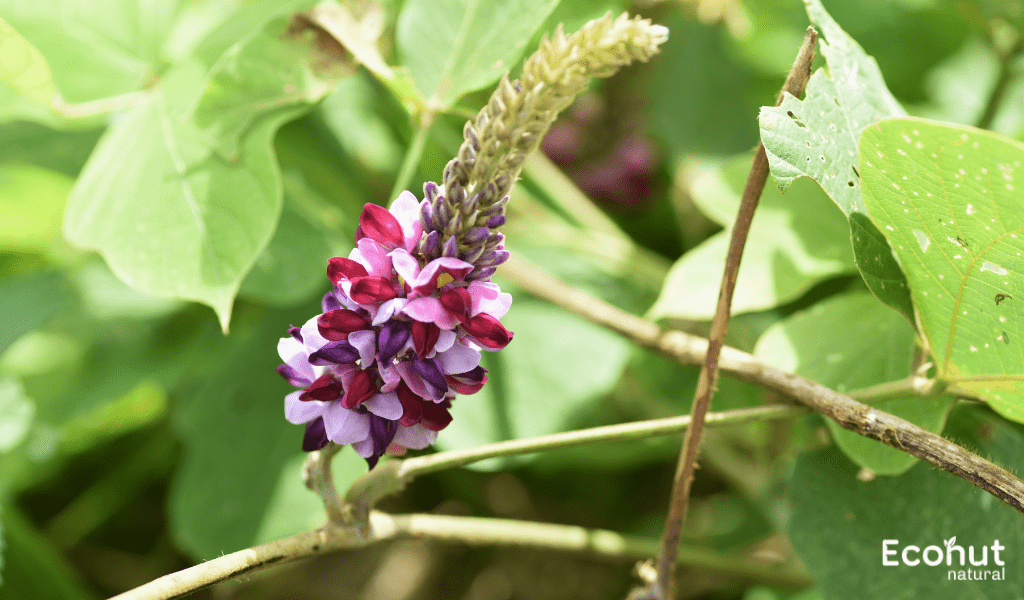Vidarikand, (Pueraria Tuberosa) also referred to as Indian Kudzu, is a perennial herb. This revitalizing herb’s tubers, or roots, are mostly utilized as a restorative tonic and immune-boosting agent. The spermatogenic property of Vidarikand roots enhances the quantity and quality of semen produced by males, which in turn raises their count and motility. They also aid in increasing the flow of mother’s milk. Additionally, fever, rheumatism, and chest pain are treated using edible Vidarikand tubers.
You will get the most benefits if you take it with milk after meals. Including Vidarikand in your diet promotes skin renewal and shine
Description
Ayurvedic medicine aims to treat humanity holistically by reestablishing the body’s natural constitution through herbal therapies and bringing humanity closer to nature. Numerous medications used in Ayurveda enhance the body’s general strength and slow down or stop the aging process. One such medication that Ayurvedic doctors frequently prescribe because of its many positive effects on human health is called vidarikand. But its most well-known uses are as a body rejuvenator and aphrodisiac.
Botanical Name:
Pueraria Tuberosa
Family:
Fabaceae
Leaves:
The pinnately compound, alternating leaves of Vidarikand contain a central stem from which several leaflets shoot out on either side. Usually, each leaf has three broadly oval or rhomboid-shaped leaflets (trifoliate).
Flowers:
The flowers of Vidarikand are blue or bluish-purple in hue. These flowers may not be the plant’s most noticeable feature because they are not particularly showy.
Stems:
Vidarikand climbs vertically and has long, trailing stems. These stems, which can grow to a maximum length of 5–6 meters (16–20 feet), aid in the plant’s ascent and sprawl over structural supports
Fruits:
Pods with seeds within are Vidarikand’s fruits. They aren’t usually used medicinally, though.
Habitat:
The Himalayan mountain range is home to tuberosa, which has also been observed to grow to 4,000 feet.
Parts Used:
- Tuber
Dosage:
- Powder – 3 to 6 gm
Chemical Constituents
Puerarin, daidzein, genistein, quercetin, irisolidone, biochanin A, biochanin B, isoorientin, and mangiferin are only a few of the bioactive substances found in tuberosa that have a wide spectrum of pharmacological actions.
Medicinal Properties of Vidarikand (Pueraria tuberosa)
Daha hara – Relieves burning sensation
Sulahara – Relieves pain
Stanya vardhaka – Promote breast milk production
Rasayana – Rejuvenative
Vajikarana – Aphrodisiac
Balya – Promotes strength
Swarya – Clarifies voice
Sophahara – Relieves swelling
Mutrala – Useful as diuretic
Other Language Names of Vidarikand (Pueraria tuberosa)
Malayalam name – Mutukku
Kannada name – Gumadigida
English name – Indian Kudju, Indian kudzu, Nepalese kudzu
Sanskrit name – Vidari, Vrisyakanda, Palasiki, Bhukushmandi, Vidarikand, Bilaikand
Hindi name – Bidarikand
Marathi name – Dari, Ghorrela
Scientific Classification
| Kingdom | Plantae |
| Class | Magnoliopsida (Dicotyledons) |
| Subclass | Rosidae |
| Order | Fabales (Legume or bean order) |
| Family | Fabaceae |
| Genus | Pueraria |
Ayurvedic Properties
Guna (Specific Action) – Guru (Heavy), Snigdha (Smooth)
Rasa (Taste) – Madhura (Sweet)
Vipaka (After Taste) – Madhura (Sweet)
Virya (Potency) – Sheeta (Cold)
Vidarikand (Pueraria tuberosa) Uses
Blood Purification:
After cooking, consume it. Blood is purified and all blood-related illnesses are healed by it.
Bulimia Nervosa:
- Give the patient 9 cc of its juice that has been boiled in 200 g of milk.
- Combine 9 gram of buffalo milk ghee with 9 cc of its juice. Give the patient this. It treats the illness.
Lactogenic:
Three times a day, give 5 grams of this powder with milk. It increases the yield of milk.
Vidarikand (Pueraria tuberosa) Benefits
For coronary artery disease:
Vidarikand may be able to prevent the progression of coronary artery disease due to its antioxidant qualities. Antioxidants included in Vidarik help fend against free radicals. This increases blood flow to the heart and reduces the risk of heart damage and coronary heart disease by making it more difficult for blood clots to form.
Alcohol Relief:
It counteracts the damaging effects of alcoholism’s radicals. It doesn’t destroy the body’s cell structure. It curbs one’s interest in drunkenness and manages the habit of cravings. Among the finest drugs to prevent alcohol use is this one.
For athletic performance:
Vidarikand increases the production of growth hormones in your body, which makes you stronger. It also makes your muscles stronger, your chest larger, and you gain weight.
Heart attack:
Vidarikand (Pueraria Tuberosa) is an antioxidant that reduces the chance of having a heart attack. Because it is beneficial to the heart, it guards against stroke. Certain ingredients in Vidarikand relax blood vessels, causing the blood to flow through arteries more quickly. This facilitates the enlargement of blood vessels, lowering vital signs and heart attack risk.
Digestive Health:
Vidarikand facilitates the secretion of digestive enzymes, which helps indigestion. It helps with constipation, indigestion, and bloating.
Skin Care:
Topical application of Vidarikand paste may help in managing skin conditions like acne and eczema.
Enhances Lactation:
It contains a naturally occurring chemical substance known as a galactagogue, which increases nursing mothers’ milk supply.
For weight loss:
vidarikand’s anti-inflammatory qualities aid in the reduction of bulk and body fat. A portion of Vidarikand reduces the impact of inflammatory genes that induce inflammation.
Don’t miss: Maricha, Black Pepper (Piper nigrum): Benefits and Side Effects
Vidarikand (Pueraria tuberosa) Side Effects
Digestive Issues:
In certain people, viderikand may result in minor upset stomach, constipation, or diarrhea.
Blood Sugar Interactions:
Vidarikand might have the ability to reduce blood sugar. Using Vidarikand may result in hypoglycemia, or dangerously low blood sugar, if you have diabetes or take blood sugar-regulating drugs.
Hormonal Effects:
People with hormone-sensitive illnesses like endometriosis or breast cancer may not benefit from Vidarikand due to the inclusion of isoflavones, which have the ability to mimic estrogen.
Conclusion
Vidariikand is a climbing plant whose leaves and tuberous roots are used to make medications for many illnesses and conditions that cause the body to rise. its key components and breadth of efficacy in treating alcoholism, skin issues, heart disease, liver disease, and respiratory ailments without having negative side effects.
FAQS
What is the purpose of vidarikand?
It is called vidari (vidari kand) in Ayurveda. According to the Ayurvedic Pharmacopoeia of India, this plant’s tuber is delicious and is commonly used to cure bronchial asthma, fever, menorrhagia, wounds, skin conditions, and jaundice.
What adverse effects does Vidari Kanda have?
Consuming vidarikand may cause negative effects such as itching, stomach problems, and disorientation. Some research suggests that eating vidarikand root internally can harm the liver.
What advantages does Vidarikand offer?
Vidarikand’s analgesic, anti-inflammatory, antiviral, and antibacterial qualities aid in the management of stomach irritation (gastritis). By lowering the synthesis of several molecules that cause inflammation, it aids in the reduction of stomach pain and inflammation.
What is Pueraria tuberosa’s botanical description?
With very enormous tuberous roots, it is a huge spreading deciduous climber or twining shrub. Three foliolate, pinnately compound leaves have lengthy petioles. Broadly ovate or rhomboid, sub-coriaceous, glabrescent above, and densely covered with silky hairs are the characteristics of leaflets.

